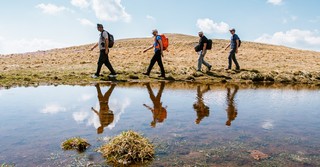Who Were the Men Who Helped Paul on His Missionary Journeys?
Share

None of us succeed alone.
We have accountability as individuals, and we make our own choices. At the same time, God designed us to have relationship with him and others. At least, that’s the ideal. Unfortunately, we live in a broken world where division and conflict happen too often.
The gospel promises a different way to live, a way that leads to an eternal future of love, righteousness, and peace. God sent his Son to initiate this spiritual revolution. Even Jesus didn’t minister alone; he brought disciples with him, passing it on to others to spread the Good News.
The most influential evangelist in the New Testament was the apostle Paul. As we read about his missionary journeys, he didn’t go alone. God called small group as the first missionaries, and Paul followed this model, along with the one Jesus set before them, to minister as a community. These men may be more obscure to us, but they were crucial to the gospel turning the world upside-down in the first century after Jesus’ resurrection and the gift of the Holy Spirit.
How Many Missionary Journeys Did Paul Take?
According to the book of Acts, the apostle Paul took three primary missionary journeys, then traveled to Rome as a prisoner.
Paul’s first journey starts in Acts 13. He served for years as one of the leaders of the church in Antioch. During a time of prayer, the Holy Spirit called Paul and Barnabas to spread the gospel. The two take a young man, Mark, with them, and they travel through Cyprus and other Asia Minor regions. Together, they preach to both Jews and Gentiles, planting new churches while facing opposition. Mark left them at some point during this journey.
For his second journey (Acts 15-18), Paul and Barnabas have a disagreement about bringing Mark again. They decide to go in separate directions. Paul takes Silas with him, visiting many of the churches he and Barnabas had planted. During his travels, God gives him a vision, calling Paul to Macedonia. Paul spreads the gospel to Europe in cities like Philippi, Thessalonica, and Corinth, planting more churches.
On his third journey (Acts 18-21), Paul again visits the planted churches, spending time in Ephesus where a revival breaks out. Many pagans reject their idols. Paul travels through Greece before coming to Jerusalem.
The Jews bring charges against Paul and he’s arrested. Being a Roman citizen, Paul appeals to Caesar, and goes to the capital of the empire in chains. While a prisoner, he still finds ways to preach in Malta and then in Rome, as well. Although it was not technically a missionary journey, he did preach and lead people to Jesus.
Photo credit: ©Getty Images/MelkiNimages

Who Traveled with Paul on His First Missionary Journey?
Barnabas and Mark went with Paul on the first journey. Barnabas’s name means “son of encouragement,” and he’s mentioned first as an early convert and elder or leader in the early church in Jerusalem, chosen by the growing church to be a spiritual shepherd and servant. Later, when Paul is converted on the way to Damascus and comes to Jerusalem, Barnabas alone takes Paul in and mentors the new believer. Barnabas takes Paul with him to help the church in Antioch.
On this first trip, Barnabas would have been seen as the leader, at least at first. Since Paul did most of the speaking, however, Acts begins to refer to the group as “Paul and his companions,” showing Paul’s increasing leadership. Barnabas was from the tribe of Levi, and like Paul, would have been useful when talking with Jewish audiences about Jesus as the Messiah.
John Mark, also called Mark, went with them as an assistant. He was Barnabas’ cousin (Colossians 4:10) and some scholars believe he wrote the Gospel of Mark. But Mark left the team early on in the journey, finding it difficult, and he returned to Jerusalem.
Getting ready for the second journey, Barnabas wanted to bring his cousin again, but Paul didn’t. This disagreement caused an issue, and so Paul and Barnabas didn’t minister together again, going on separate journeys. However, Paul eventually reconciled with Mark and found him important for ministry, revealing a restoration (2 Timothy 4:11).
Photo credit: ©Getty Images/Lifestyle Visuals

Who Helped Paul on the Second Journey?
Paul took a different group with him on his second journey, where he was definitely the leader and main speaker. These men — Silas, Timothy, and Luke — each played a huge role in Paul’s life and ministry.
Also known as Silvanus, Silas was a leader and prophet in the Jerusalem church. Silas was a Roman citizen like Paul, and this helped them deal with legal issues in Roman cities. Silas suffered in prison with Paul in Philippi. But when the two men sang hymns, an earthquake freed them. Silas also co-authored letters to churches like 1 and 2 Thessalonians.
Timothy joined Paul and Silas in Lystra (Acts 16:1-3). A young man, Timothy had a Jewish mother and Gentile father. Paul led him to Jesus and started mentoring him, like a father figure, and had Timothy circumcised to keep from offending the Jews. This was interesting, considering Paul didn’t believe circumcision was required for salvation (Galatians 2:3-5). Timothy eventually became a type of apostle, one of Paul’s most trusted and loyal coworkers, representing Paul in church situations (Philippians 2:19-22). Paul even called him his beloved son (1 Timothy 1:2).
Luke joins the journey in Acts 16:10. Here, the writing of Acts shifts from “they” to “we,” since Luke authored both Acts and the Gospel of Luke. Luke traveled with Paul from Troas to Philippi. Luke was a physician and probably helped the ministry team with any medical needs. His education helped him write an accurate historical account.
Photo credit: ©Getty Images/sgolan20

Who Ministered with Paul on the Third Journey?
For Paul’s third journey, he had more experience and identified more leaders for the increasing church network, so his team also grew. He brought Timothy, Luke, Trophimus, Tychicus, Gaius, Aristarchus, and Sopater. We see an interesting pattern. The first journey were all Jews. With the second journey, we see a blend of Jew and Gentile. Now, with the third journey, Paul exclusively brought Gentile believers as leaders. This makes sense, since the churches were becoming majority Gentile.
As we’ve already discussed Timothy and Luke, we’ll cover the other five men.
Trophimus, a Gentile from Ephesus (Acts 21:29), traveled with Paul and likely helped Paul gather the contributions for the suffering and poor in Jerusalem. His presence among the team influenced the riot in Jerusalem that led to Paul’s arrest.
Tychicus, another Gentile, served with Paul and carried Paul’s letters to churches in Ephesus and Colossae. While not mentioned in the Bible, scholars believe he helped Paul send instructions and encouragements to other churches during Paul’s imprisonment.
Gaius and Aristarchus, both from Macedonia, traveled with Paul while he was in Ephesus and were also grabbed by the mob during a riot (Acts 19). Aristarchus sailed with Paul to Rome (with Luke, as well) in Acts 27, showing his amazing loyalty. Sopater of Berea (Acts 20) joined the missionary team during Paul’s return trip through Macedonia toward Jerusalem.
Photo credit: ©Getty Images/Finn Hafemann

What Other Support Did Paul Have?
Besides the men who traveled with Paul, he also had amazing support from churches and saints throughout his journeys, meeting several important needs.
The church in Antioch supported Paul from the beginning. They fasted, prayed, and commissioned Barnabas and Paul. They also welcomed them back and rejoiced at the report of conversions and churches (Acts 14). Since Paul had been part of that church for over a decade, Antioch became a model and home base for him as he planted churches and taught believers of diverse cultures together to love one another.
The Philippian church also supported Paul with generous monetary gifts. Paul mentions them, praising them for financially supporting him, even when other churches didn’t (Philippians 4:15-18). The apostle further describes their gifts as a fragrant offering to God and promised the Lord would meet their needs, as well.
Pricilla and Aquila, a married couple, helped Paul find work in tentmaking, provided housing, and partnered with him in ministry (Acts 18:2-3 and Romans 16:3-4). Paul writes how they risked their lives for him, and he treats them like close friends and respected ministers.
In several major cities, the locals opened their homes to Paul and hosted churches and meetings. Lydia had Paul and his team stay in her house in Philippi after she came to faith in Christ (Acts 16:14-15). Jason in Thessalonica gave Paul and Silas hospitality and faced violence from the mob for doing so (Acts 17).
Further, Paul asked for and likely got prayers from the different churches with whom he communicated. His letters listed things people should pray for, primarily the success of the gospel.
Photo credit: ©Getty Images/wwing

What Can We Learn from these Men and Women?
Paul teaches us an important truth. We can’t serve God alone. Paul might easily be the most famous early missionary and biblical author. But he didn’t do any of it in isolation. Every church he planted, letter he wrote, and journey he took involved others who stood with him in faith and sacrifice. From Acts, we see how during his most difficult time, persecuted by the Jews and sent to Rome as a prisoner to bring his case to Caesar, men like Luke traveled with him. Others abandoned him along the way (2 Timothy 4:9-11).
Along with men who traveled with him, churches and married couples and individuals provided money, housing, and prayer. These relationships were all essential to the mission. Paul regularly named his co-laborers in his letters, thanking and affirming them, dignifying even minimal contributions. He wept at times, longing to see people he loved again.
This teaches us how God designed the Church to function as a Body and a family, many parts working together, all necessary (1 Corinthians 12:12-27). No one part can do it alone. When we try to minister without community, we cut ourselves from the wisdom, encouragement, strength, and accountability we need from others following the Spirit. Again, Jesus preached the gospel with others around him, his disciples. So did Paul. We need the same. God didn’t design the gospel to be carried alone.
While some things in the Bible are individual – our choices and repentance to God alone – we must learn our need for the local church. Too many reject the church because of hurt and imperfect people. Church hurt and disappointment can be valid. Paul dealt with these issues, too, feeling abandoned and betrayed by those who claimed faith. Yet he didn’t reject community and the Body of Christ. He continued to commit himself to the growth of believers and showing them love.
It's not just “me and God,” like we don’t need others. Paul specifically tells us we can’t say we don’t need other believers (1 Corinthians 12:21). We need deep, Christ-centered relationships with fellow believers. People from different backgrounds, races, and cultures acting like a loving family is part of preaching the gospel. We must encourage each other, bear one another’s burdens, and encourage each other to love and good works (Hebrews 10:24). Every one of us has a role, worthy of celebration, dignity, and affirmation.
Paul’s life models how the gospel thrives through community and mutual support. To embrace the call of God, we must embrace community, spiritual family, and humility. Together, we reveal Christ to the world.
Photo credit: ©Getty Images/Katarzyna Bialasiewicz
